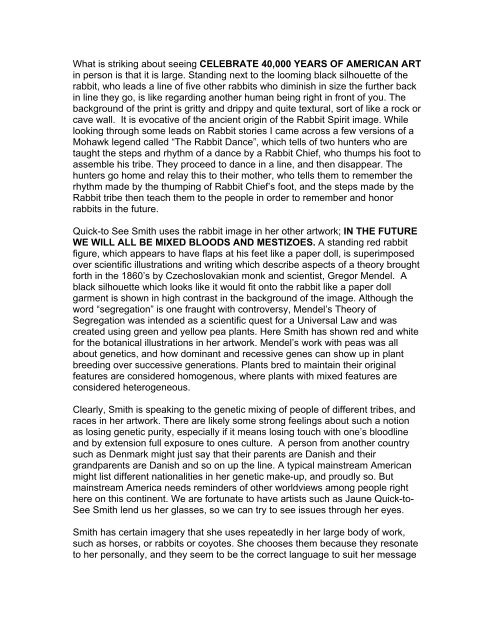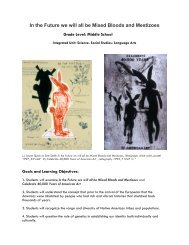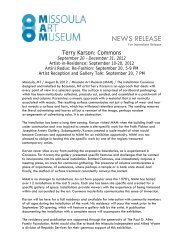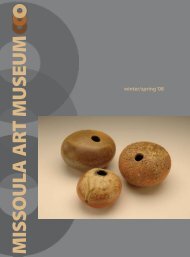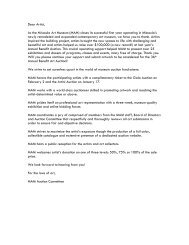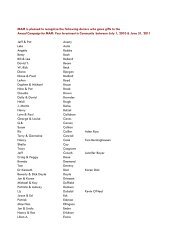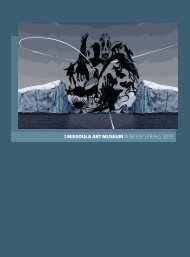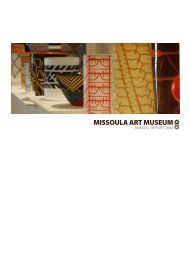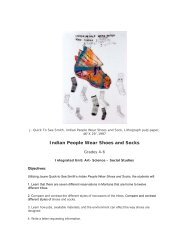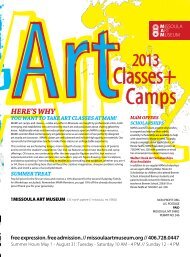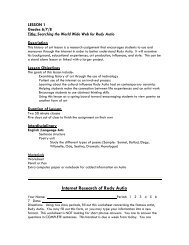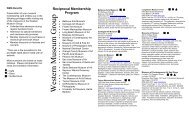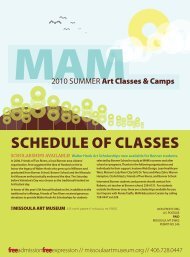Reading Into Rabbits - Missoula Art Museum
Reading Into Rabbits - Missoula Art Museum
Reading Into Rabbits - Missoula Art Museum
Create successful ePaper yourself
Turn your PDF publications into a flip-book with our unique Google optimized e-Paper software.
What is striking about seeing CELEBRATE 40,000 YEARS OF AMERICAN ART<br />
in person is that it is large. Standing next to the looming black silhouette of the<br />
rabbit, who leads a line of five other rabbits who diminish in size the further back<br />
in line they go, is like regarding another human being right in front of you. The<br />
background of the print is gritty and drippy and quite textural, sort of like a rock or<br />
cave wall. It is evocative of the ancient origin of the Rabbit Spirit image. While<br />
looking through some leads on Rabbit stories I came across a few versions of a<br />
Mohawk legend called “The Rabbit Dance”, which tells of two hunters who are<br />
taught the steps and rhythm of a dance by a Rabbit Chief, who thumps his foot to<br />
assemble his tribe. They proceed to dance in a line, and then disappear. The<br />
hunters go home and relay this to their mother, who tells them to remember the<br />
rhythm made by the thumping of Rabbit Chief’s foot, and the steps made by the<br />
Rabbit tribe then teach them to the people in order to remember and honor<br />
rabbits in the future.<br />
Quick-to See Smith uses the rabbit image in her other artwork; IN THE FUTURE<br />
WE WILL ALL BE MIXED BLOODS AND MESTIZOES. A standing red rabbit<br />
figure, which appears to have flaps at his feet like a paper doll, is superimposed<br />
over scientific illustrations and writing which describe aspects of a theory brought<br />
forth in the 1860’s by Czechoslovakian monk and scientist, Gregor Mendel. A<br />
black silhouette which looks like it would fit onto the rabbit like a paper doll<br />
garment is shown in high contrast in the background of the image. Although the<br />
word “segregation” is one fraught with controversy, Mendel’s Theory of<br />
Segregation was intended as a scientific quest for a Universal Law and was<br />
created using green and yellow pea plants. Here Smith has shown red and white<br />
for the botanical illustrations in her artwork. Mendel’s work with peas was all<br />
about genetics, and how dominant and recessive genes can show up in plant<br />
breeding over successive generations. Plants bred to maintain their original<br />
features are considered homogenous, where plants with mixed features are<br />
considered heterogeneous.<br />
Clearly, Smith is speaking to the genetic mixing of people of different tribes, and<br />
races in her artwork. There are likely some strong feelings about such a notion<br />
as losing genetic purity, especially if it means losing touch with one’s bloodline<br />
and by extension full exposure to ones culture. A person from another country<br />
such as Denmark might just say that their parents are Danish and their<br />
grandparents are Danish and so on up the line. A typical mainstream American<br />
might list different nationalities in her genetic make-up, and proudly so. But<br />
mainstream America needs reminders of other worldviews among people right<br />
here on this continent. We are fortunate to have artists such as Jaune Quick-to-<br />
See Smith lend us her glasses, so we can try to see issues through her eyes.<br />
Smith has certain imagery that she uses repeatedly in her large body of work,<br />
such as horses, or rabbits or coyotes. She chooses them because they resonate<br />
to her personally, and they seem to be the correct language to suit her message


